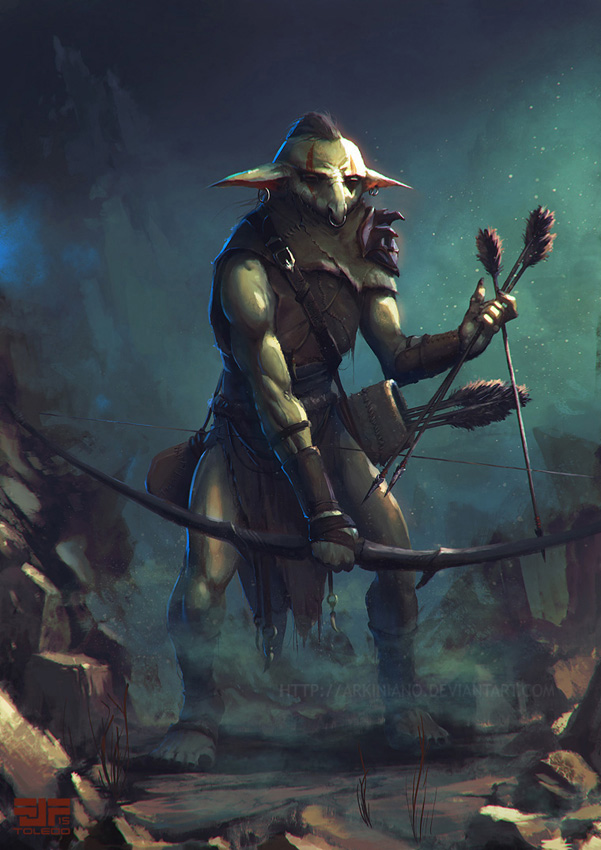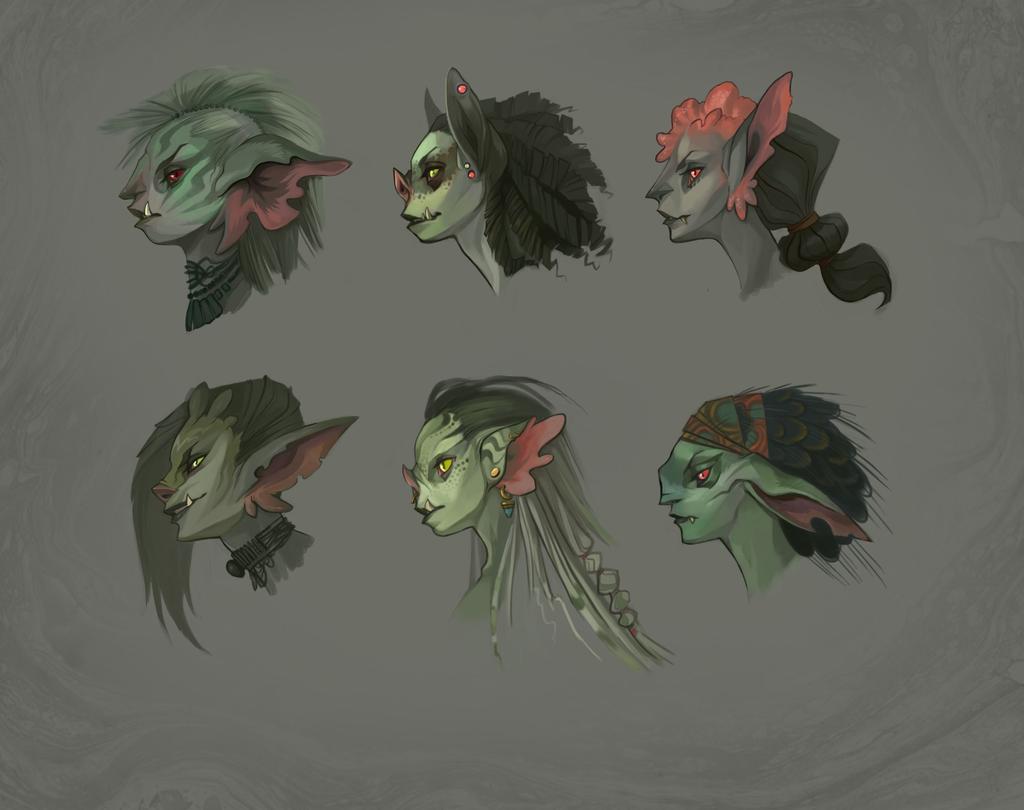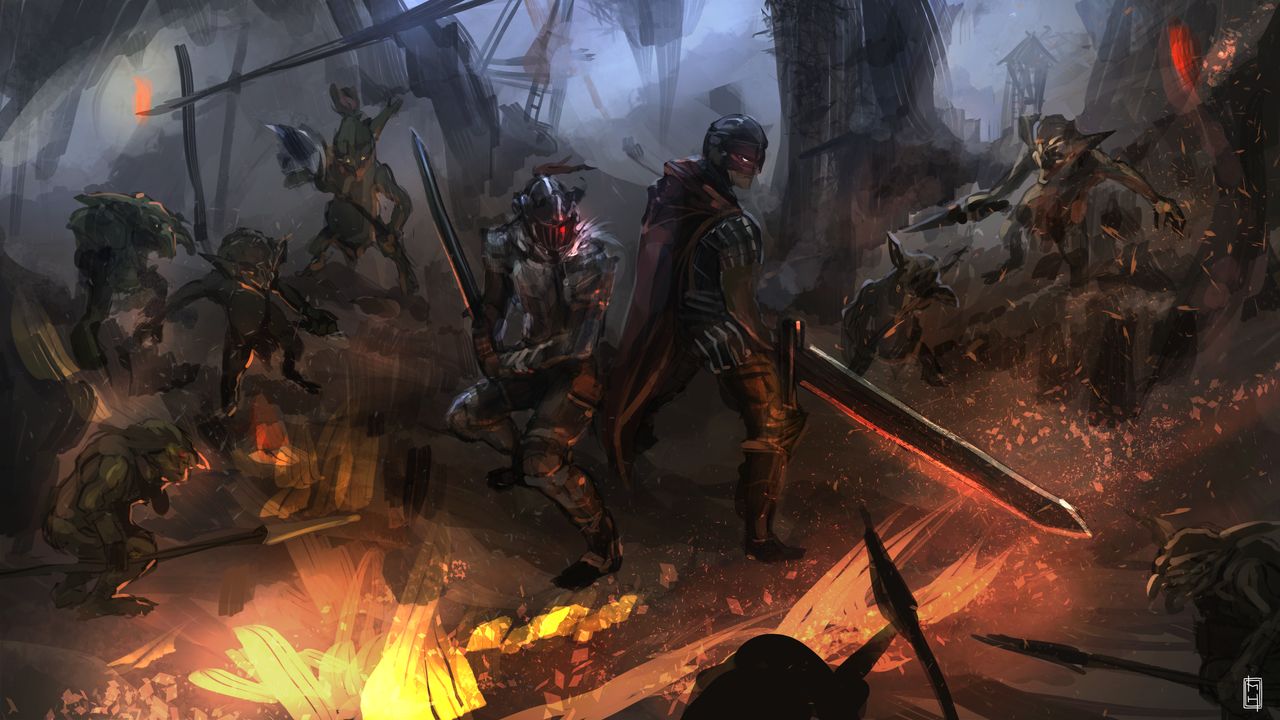Goblins
A Vicious Cycle...
History
Goblins were created to function in a hive mind. The hive mind centers around a brood King for every colony. Any one colony can be radically different from another depending on how the brood King wishes to develop and mutate their own spores. This leads to the variation in lifespan between different broods of goblin as well as radically different physical characteristics. The broods with superior numbers are known for short life spans ranging anywhere from 10 to 30 years. Some last considerably longer, but goblins will rarely reach fifty years of age, at most.
It is a common stereotype that goblins are unintelligent. The stereotype stems from the differences between bound goblin broods and Unbound Goblin Broods. A bound Goblin brood still lies under the control of a brood king. When a brood King dies the entire brood becomes unbound, each and every one of its number is released and given free will. They immediately go about experimenting with the world around them.
Every Goblin possesses photographic memory and profound curiosity, allowing them to pass on memories and skills as well as personal traits to later generations. After approximately four generations, an unbound brood becomes incredibly intelligent and sophisticated. Their weaponry is often considered some of the greatest examples of craftsmanship in the world, and their various contraptions they invent rival even the greatest marvels of science and technology that stem from Lartasia .
It is a common stereotype that goblins are unintelligent. The stereotype stems from the differences between bound goblin broods and Unbound Goblin Broods. A bound Goblin brood still lies under the control of a brood king. When a brood King dies the entire brood becomes unbound, each and every one of its number is released and given free will. They immediately go about experimenting with the world around them.
Every Goblin possesses photographic memory and profound curiosity, allowing them to pass on memories and skills as well as personal traits to later generations. After approximately four generations, an unbound brood becomes incredibly intelligent and sophisticated. Their weaponry is often considered some of the greatest examples of craftsmanship in the world, and their various contraptions they invent rival even the greatest marvels of science and technology that stem from Lartasia .
A Vicious Cycle
This is how goblins lived for a considerable period of time. A brood king would die, unbinding The Brood, and the brood would experiment and learn how the world works. They would pass on what they learn to to the next-generation, and the process would continue. However, new brood Kings can often be born out of subsequent broods, and if they are able to survive, they will combine the minds of all goblins in their brood that share the same genetic line. Other brood Kings can come and take over unbound broods, combining the genetic lines into a new brood. This is the primary reason why goblins never became a civilization.
Kings can appear at any given point in time within a generation. Once they establish a connection with the brood, all their progress is lost. When a goblin brood becomes unbound once more, almost all the information they once had will be gone. One piece of information will remain. They will know what it was like to live on both sides of the coin. As the brood kings died once more, and unbound broods resurfaced, the Goblins were left with a single goal: ensure it never happens again.
The goblins paid close attention to each new generation, killing indiscriminately should a member of the brood exhibit qualities even remotely similar to a brood king. This would not protect them from brood kings that sought to annex their brood. They then stumbled upon the trolls. Trolls are large and remarkably unintelligent, likely the product of a brood king seeking to create the biggest and most powerful brood. Trolls possess no brain and come in a variety of shapes and sizes but they could prove useful in protecting a goblin brood if they can be tamed and controlled.
Kings can appear at any given point in time within a generation. Once they establish a connection with the brood, all their progress is lost. When a goblin brood becomes unbound once more, almost all the information they once had will be gone. One piece of information will remain. They will know what it was like to live on both sides of the coin. As the brood kings died once more, and unbound broods resurfaced, the Goblins were left with a single goal: ensure it never happens again.
The goblins paid close attention to each new generation, killing indiscriminately should a member of the brood exhibit qualities even remotely similar to a brood king. This would not protect them from brood kings that sought to annex their brood. They then stumbled upon the trolls. Trolls are large and remarkably unintelligent, likely the product of a brood king seeking to create the biggest and most powerful brood. Trolls possess no brain and come in a variety of shapes and sizes but they could prove useful in protecting a goblin brood if they can be tamed and controlled.

by fjft-ar
Acceptance
The Verdant Races have always been considered an enemy. Many believed that The Verdant Races were savages. However, there was a single Goblin warchief named Grum that changed this perception. Chief Grum learned how to speak the common tongue from a scholar that was found trespassing on their land.
Grum sought audience with Tammer Roux, King of Estoya, who found their correspondence delightful and still maintains communication. The king declared that the verdant races could be allowed into cities provided they follow the law. The agreement has been alarmingly successful.
Grum sought audience with Tammer Roux, King of Estoya, who found their correspondence delightful and still maintains communication. The king declared that the verdant races could be allowed into cities provided they follow the law. The agreement has been alarmingly successful.
Goblin Religion
The Goblins rarely worship deities. Instead, they often choose to worship domains, or the anthropomorphic Titans that speak for those domains.

by ulafish
Remove these ads. Join the Worldbuilders Guild


Comments